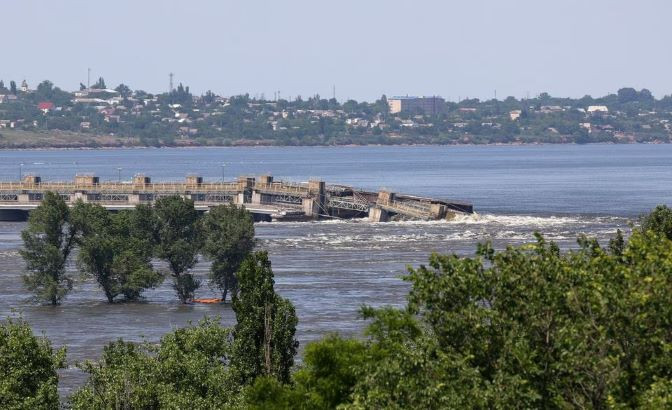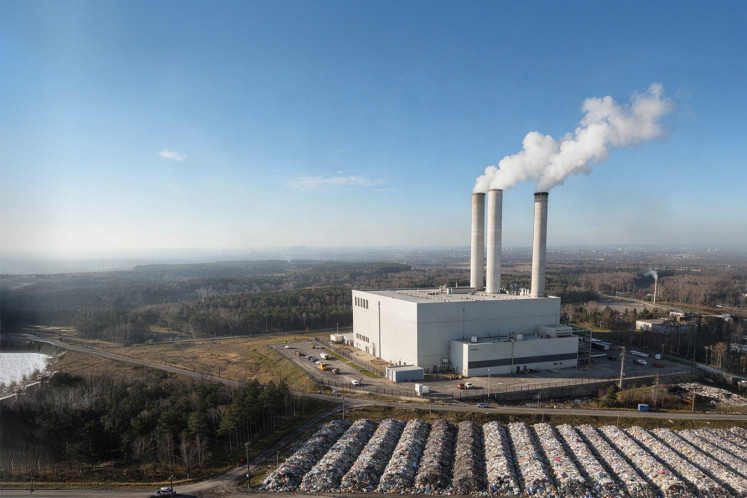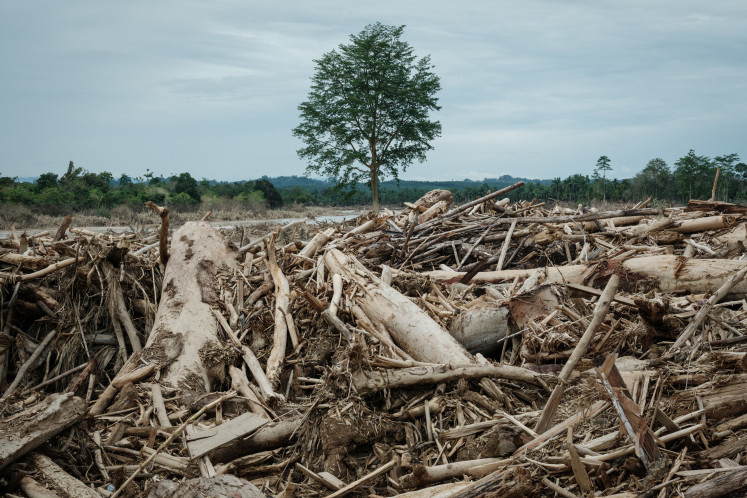Popular Reads
Top Results
Can't find what you're looking for?
View all search resultsPopular Reads
Top Results
Can't find what you're looking for?
View all search resultsTactical implications of the Nova Kakhovka dam destruction
By destroying the dam, Russia gains tactical advantages in this strategic region. The resulting flood has created obstacles that may slow down the long-awaited Ukrainian offensive.
Change text size
Gift Premium Articles
to Anyone
E
ver since the initiation of Russia's conflict against Ukraine, the Nova Kakhovka dam has been identified as a high-value target due to its strategic importance. It was seized by Russian forces during Moscow's invasion in February 2022 and has remained under their control since then.
In the early morning of June 6, the dam, located on the Dnipro River, collapsed, resulting in one of the most significant human and environmental disasters since the war began in Ukraine. The dam, situated 30 kilometers east of the city of Kherson, holds substantial implications for the broader war effort.
Both Moscow and Kyiv have started accusing each other of what could arguably be considered a war crime. The destruction of the dam occurred just as Ukraine was preparing for a long-awaited counter-offensive in this strategic region.
Civil engineering experts, intelligence analysts, and officials have proposed three main theories regarding the cause of the collapse. First, it is suggested that Russia might have blown up the dam. Ukrainian President Volodymyr Zelensky, his government, and the country's military swiftly blamed Moscow for the dam's destruction. They pointed out that the dam had been under Russian control for the past year. So, it was an easy task for the Russian army to plant explosives accurately.
People in the area reported hearing explosions at the time when the dam was presumed to be damaged. Moscow may have sought to impede Ukraine's anticipated counter-offensive. Moreover, the reservoir supplies cooling water to the Zaporizhzhia nuclear power plant, Europe's largest nuclear power station, making its safety crucial.
Second, it is possible that artillery attacks by Ukraine caused sufficient damage to the dam. The Kremlin accused the Kyiv regime to deprive Crimea of water, which Russia annexed in 2014. It also brought the worst disaster to the Russian-controlled area, which had served as a launching pad for Russian military operations in the past. There were reports that Russian forces were caught off guard during the collapse.
Third, the destruction could be attributed to structural failure. The dam had already sustained some prior damage, as satellite images showed partial damage from June 1 and 2. Additionally, the water level had risen to a record 17.5 m in April, which had posed a risk to the dam intact.
Now let us analyze the military tactical implications for both parties concerning the destruction of the dam. First, Russia has historical precedents for such actions. In 1941, Stalin ordered to destroy of a dam across the Dnipro River to make the approach inaccessible for advancing German forces. Furthermore, during Napoleon's invasion in 1812, Russia implemented a "scorched earth policy", leaving the French Army with little sustenance and only the smoldering ruins of Moscow to capture.
By destroying the dam, Russia gains tactical advantages in this strategic region. The resulting flood has created obstacles that may slow down the long-awaited Ukrainian offensive, impeding the movement of troops, armored vehicles, and heavy machinery for the next few weeks. This has compelled the Ukrainian army to allocate resources to address the humanitarian emergency and reassess their counter-offensive plan.
Undoubtedly, it is a morale victory for the Russian army and represents a significant strategic achievement. Maintaining the status quo on the occupied territories will place Ukraine under pressure, as it has been preparing for a counter-offensive with Western-trained troops and advanced weaponry. Ukraine is facing a 1,000 km line of Russian defense. If Russia could repulse the offensive maneuver of the Ukrainian army, then it will increase the political pressure on Ukraine and the West. This will be potentially leading to the consolidation of Russia's gains and Ukraine has to accept the ceasefire proposal of China.
However, if Ukraine is indeed behind the destruction of the dam, it is crucial to consider the tactical advantages achieved by the Ukrainian forces. This act could potentially facilitate the relocation of the Ukrainian army to the north bank of the Dnipro River, enabling them to sustain a long-awaited counter-offensive.
Ukrainian forces intent to recapture significant portions of territory in the south of the country. Kyiv's objective is to breach Russia's defense lines to the south of Zaporizhzhia, effectively splitting the territory and isolating Crimea, thereby achieving a major strategic victory. The resulting flood could also aid the Ukrainian side in dispersing Russian troops and retaking areas that connect Crimea to the eastern Donbas region.
While the details and background of the dam's destruction remain unclear, but the wider multifaceted short-term and long-term consequences are catastrophic. The destruction of the dam has disrupted the livelihoods of residents in Kherson, Dnepropetrovsk, and Zaporizhzhia. It has devastated the ecosystem, basic infrastructure, irrigation systems, and clean water facilities.
Furthermore, it has impacted significantly on the country's energy security. The breach of the dam will have long-term effects on agricultural production and food security. A massive volume of freshwater will flow into the Black Sea, affecting the salinity of the Dnipro Delta.
It is more likely that hundreds of thousands of people will become ecological refugees in southeastern Ukraine in the coming years. Additionally, it is worth noting that the Geneva Conventions explicitly prohibit attacks on dams, dikes, and nuclear power plants where this incident would comply with an act of war crime.
As the extent of the destruction becomes evident, the International Committee of the Red Cross has warned of a “significant” threat to civilians. This act appears to be an attempt to inflict long-term damage on the viability of Ukraine as a functioning society and economy.
The destruction of the Nova Kakhovka Dam has taken the conflict to new heights since the war's inception.
***
The writer is a political and defense analyst based in Bangladesh.











